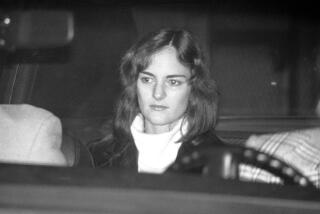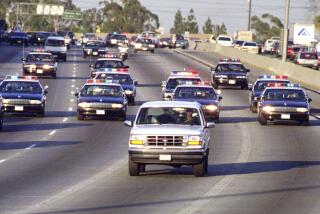Last SLA Fugitive, on Run Since ‘75, Held in S. Africa
- Share via
SAN FRANCISCO — SAN FRANCISCO -- After a generation on the run, the last Symbionese Liberation Army fugitive was arrested Friday in South Africa, a day after four allies from the radical 1970s group pleaded guilty to a 27-year-old murder in Sacramento.
FBI officials said South African police apprehended James William Kilgore, 55, without incident at the home he shared with his wife and two young children in the upscale Cape Town suburb of Claremont.
Mark Mershon, FBI special agent in charge of the San Francisco office, said Kilgore, an instructor at the University of Cape Town, was shown a wanted poster and asked if he was the man. “Yes, that’s me,” Kilgore responded, Mershon said.
Kilgore’s wife, an American who also worked at the university, was at home at the time of the arrest but was not taken into custody.
“He is a very rare fugitive who entirely cuts off his past and lives in a vacuum,” Mershon said.
FBI officials said Kilgore had lived in South Africa since 1989. But a spokeswoman for the South African Police Agency, Mary Martins-Engelbrecht, said the fugitive entered the country five years ago using a false name. Police believe he may also have spent several years in Zimbabwe.
Kilgore had been on the run since 1975, shortly before he was indicted for allegedly possessing a destructive device after authorities recovered explosives at an SLA hide-out near San Francisco. He also faces charges as a participant in the robbery of a suburban Sacramento bank that ended in the shotgun slaying of Myrna Opsahl, a 42-year-old mother of four.
William Harris, Emily Harris Montague, Michael Bortin and Sara Jane Olson pleaded guilty to that murder Thursday as part of a deal that called for jail terms of six to eight years, sparing them a trial that could have meant life in prison.
Opsahl’s family expressed relief over the capture. Jon Opsahl, who spent much of his adult life in a quest to bring his mother’s killers to justice, said he would like to see Kilgore accept the same plea deal given to the four others.
“He’s just kind of a loose end that’s out there, and if we can get it wrapped up and have him admit his guilt in the Carmichael bank robbery and my mother’s murder and serve his time, it would be better for everyone involved,” he said.
U.S. Atty. Kevin Ryan said the timing of Kilgore’s arrest, less than 24 hours after the four other former SLA members admitted their guilt in court, was purely coincidental and not part of the earlier plea deal.
Mershon said there had been discussions about Kilgore voluntarily surrendering. But the FBI, he said, continued to pursue him as a wanted felon.
The agency had suspected since the early 1980s that he might be hiding somewhere in Africa. South African police had been hunting for Kilgore for several months. FBI agents received a tip about 10 days ago, narrowing the search to Cape Town, Mershon said.
“This man has been wanted by the FBI for almost 30 years,” he said. “This has never been a cold case.” The timing of the arrest “is truly a coincidence,” he said. “Life is full of coincidences.”
Several defense attorneys in the Sacramento murder case said Kilgore had been trying through a lawyer on the East Coast to negotiate his voluntary surrender and a plea bargain similar to those accepted by his former comrades in the SLA.
“It seems mean-spirited to do it this way,” said Alex Reisman, a San Francisco attorney who represent William Harris. “Why didn’t they just let him turn himself in? There’s no such thing as coincidences.”
Ryan also denied reports that Kilgore had been negotiating with at least one defense attorney representing other SLA members.
“The negotiations [in Sacramento] have no part in what transpired here,” Ryan said. “There was no cooperation between the defense team in that case and this arrest. The two are not attached in any way.”
In South Africa, Kilgore adopted the pseudonym Charles William Pape and taught English at the University of Cape Town.
C.W. Pape is listed on the university’s Web site as project coordinator for the International Labor Resource and Information Group, known as a left-leaning think tank.
Kilgore was being held over the weekend at the Claremont jail and was scheduled to appear in a South African court Monday.
Ryan said he planned to immediately extradite Kilgore to San Francisco to stand trial on federal charges of possession of an unregistered explosive device, a pipe bomb that authorities found in 1976 among possessions being moved from an SLA safe house in Daly City, a San Francisco suburb. The charges carry a penalty of up to 10 years in prison and a $10,000 fine. Kilgore also is expected to face the Sacramento murder charges.
“We expect to see Mr. Kilgore in this district soon and expect to prosecute him to the fullest extent of the law,” Ryan said.
A Portland, Ore., native, Kilgore grew up in the Bay Area and attended San Rafael High School in Marin County. His father was a wealthy Marin County lumber dealer.
Steve Patterson, a classmate of Kilgore at San Rafael High School, described him as a popular, “almost brilliant guy” with an offbeat sense of humor. “He was not a sinister character. He came from a really good family; he was a really well-adjusted guy.”
In 1969, Kilgore graduated from UC Santa Barbara with a degree in economics. By then, Patterson said, it was clear that “getting caught up in politics had pushed him over the top” in a radical direction.
Kilgore’s introduction to the SLA came along with his girlfriend, Olson, known then as Kathleen Soliah.
A sports enthusiast, Kilgore had dropped out of a graduate program in economics at UC Santa Barbara and was thinking of becoming a sportswriter or a photographer, according to “The Voices of Guns,” a book about the SLA.
Instead, he wound up getting work as a house painter for Michael Bortin, at the time a Berkeley student who had started his own contracting company.
Kilgore and Soliah joined the SLA after Soliah gave an impassioned speech at a memorial rally in Berkeley for six members of the group who died in a shootout with Los Angeles police. Newspaper heiress Patricia Hearst, who had been kidnapped and converted to the group’s cause, recalled going with Bill and Emily Harris to meet them at a drive-in movie theater in Oakland.
“They were parked in the movie section showing ... a soft-core porno film called ‘Teacher’s Pet,’ ” she recalled in her book, “Every Secret Thing.” “Jim Kilgore looked like the typical intellectual, unkempt Berkeley student, with wire-rim spectacles, 6 feet tall with medium-brown long hair, wearing a wrinkled T-shirt. He also had, I noticed, a little paunch.”
In her book, Hearst portrayed Kilgore as a voice of moderation, or what passed for it in the immoderate world of the SLA.
During that introductory meeting, Hearst wrote, Soliah said she was ready to go underground and get involved in revolutionary action. Kilgore’s response, Hearst said, was: “No! I don’t think any of us should get into any action now. It is just too hot for that.”
At another point, Hearst describes a day when the group was hiding in an apartment in Berkeley and heard sirens on the street outside. Looking out the window, they saw firetrucks. “Combat positions!” yelled Bill Harris, according to Hearst. Kilgore, she said, calmly suggested that the appearance of firetrucks probably meant there was a fire nearby, which turned out to be the case.
“Jim Kilgore,” she wrote, “was the model of reason.”
Hearst wrote that he argued against using guns in the robbery of a Crocker National Bank branch in Carmichael, in which Emily Montague now says her shotgun went off accidentally, killing Opsahl as she arrived to count church receipts.
“You better not take that gun,” Hearst quotes Kilgore as telling Montague, then known as Emily Harris. “It’s got a hair trigger and, besides, you don’t need a shotgun inside a bank.”
The hunt for Kilgore intensified after Olson’s arrest in 1999. He was featured on the TV show “America’s Most Wanted,” which yielded several hundred tips. But until recently, authorities said, there had not been a single confirmed sighting of him in more than two decades.
*
Bailey reported from Sacramento, Glionna from San Francisco. Times staff writers Mitchell Landsberg and Geoffrey Mohan in Los Angeles contributed to this report.
More to Read
Sign up for Essential California
The most important California stories and recommendations in your inbox every morning.
You may occasionally receive promotional content from the Los Angeles Times.











